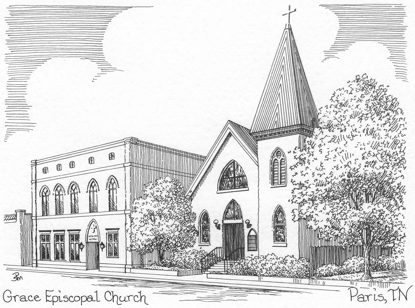
Located only a half block from the Henry County Courthouse on the town square, historic Grace Church, is the oldest church building in Henry County.
Three women, Mrs. F. A. Upchurch, Mrs. J. N. Thomason, and Mrs. Thomas P. White founded Grace Church, Paris in 1894. According to records they felt “deprived and at a loss without their church, (and) decided that, if humanly possible and with God’s help, the Cross of Christ would be lifted over an Episcopal Church in Paris.” In 1895 a lot was purchased in downtown Paris. The original lot was enlarged through a gift from W B. Jones so that it was “wide enough for a two horse carriage to draw coal to the furnace.”
The women, who were appointed Trustees by Bishop Charles Todd Quintard in 1895, “wrote hundreds of letters, asking for subscriptions, held suppers, bazaars, benefits, etc., being very grateful to the ladies of other denominations for their assistance” in an effort to raise money for the building.
In 1895, under the supervision of the three founders and with the “advice and assistance” of Mr. William Stalls, construction on Grace Church was begun. Mr. Stalls had become interested in building the church due to the “zealousness” and various “books loaned me” by the founders. The chancel was designed by Mrs. Thomason and includes seven arches. The general architectural lines of the church are similar to those of the famous `Wee Kirk 0′ the Heather’ at the Forest Lawn Cemetery, Hollywood, CA. Following tradition, Grace Church faces east so that the rays of the rising sun fall upon the altar.
Through the generosity of many people, historic Grace Church was completed in 1904 at a cost of $3,500. As an example of the extraordinary fund-raising efforts by the three Trustees, J. P. Morgan, the great financier, contributed $250.00 for the roof. The Church was consecrated on November 12, 1904.

In 1980 the former Capitol Theater next door was purchased. A later bequest from Nelle Ketchum allowed the loan to be paid in full. Following several renovations Ketchum Hall became the parish hall for Grace Church.
In 1998-99 a restoration of the facilities was completed restoring the historic church to its original beauty. Ketchum Hall was modified to include new administrative offices, nursery facilities and Christian education rooms. Driess-Founder’s Hall, the original parish hall, became a large meeting room with kitchen. An enclosed memorial garden with a Columbarium separates the church from Ketchum Hall.
In 2013, our Tiffany window was discovered to have suffered some damage. A church – wide effort to pool resources for the cost of professional restoration to this priceless historic community treasure soon resulted in the funds needed for the restoration, which was completed in 2014.
Our Historic Stained Glass Windows

The large window over the Altar is an image of Jesus Christ at his Second Coming. It is a Tiffany-designed window, built at the Tiffany plant in Versailles, France. Each piece was separately wrapped in straw and placed in wooden kegs for shipment to Philadelphia, PA. From there it was taken by horse-drawn wagon to the Berghause Company in Lancaster, PA where the window was constructed in its present form. Once completed, the window was suspended on steel rods in a vertical position, wrapped in heavy sheets of wool, and put on a flat rail car to be brought to Paris. Once arriving in Paris, it was suspended on a rope-made bed drawn by six horses and brought to the intersection of Blythe and Fentress Streets. Employees of the Berghause Company carried the window the remaining two and a half blocks to Grace Church. The installation was completed in 5 working days. The total cost was $1800.00. It is believed to be one of the earliest Tiffany-designed windows in the United States. Bishop Charles Todd Quintard donated the window. After his death, Mrs. Upchurch and other willing workers raised the funds and paid for the Chancel window in memory of Bishop Quintard.

The windows on the side of the church are called lancet windows. They also were designed and constructed by Tiffany. They reflect four colors from top to bottom. The blue Lapis Lazuli represents the heavens, the golden ember of the sun, the natural green of the earth and the blood red of the fires inside the earth. They were shipped to Paris at the same time as the large chancel window and were installed in 1895.

Two large, lovely rose windows sit above the entrance at the west end of the church. The original glass faded in the direct afternoon sunlight, so in 1966 the children of Mrs. Margaret Weber Trevathan refurbished the windows as a memorial to their mother. The “new” glass pieces were individually gathered from the great cathedrals of Europe that were destroyed during the first and second world wars. In fact, some of the glass dates from as early as the 15th century.
